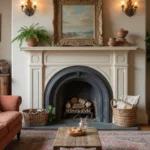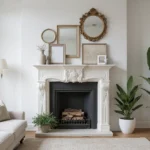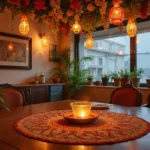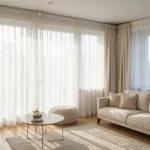Choosing the right paint color for a small bedroom can completely transform your space, making it feel larger, cozier, or more luxurious. We’ve seen countless tiny rooms go from cramped to captivating with just the right shade on the walls. That’s why we’ve compiled this essential guide to the best paint colors for small bedrooms.
In our experience working with compact spaces, we’ve discovered that color selection isn’t just about aesthetics—it’s a powerful tool for spatial perception. The right paint color can visually expand walls, heighten ceilings, and create an atmosphere that perfectly suits your style preferences. We’ll share our top recommendations that interior designers consistently turn to when working with limited square footage.
10 Best Paint Colors for Small Bedrooms That Create Space and Style
1. Soft White (Benjamin Moore’s “White Dove”)
White Dove offers a clean, bright foundation that maximizes natural light in small bedrooms. This warm-toned white creates an airy atmosphere without feeling sterile or cold. Interior designers frequently recommend this shade because it reflects light beautifully, making walls appear to recede and ceilings feel higher. We’ve noticed small rooms painted in White Dove often appear significantly larger, especially when paired with matching trim for a seamless look.
2. Pale Blue (Sherwin-Williams’ “Atmospheric”)
Atmospheric by Sherwin-Williams delivers a serene, sky-inspired blue that visually expands small bedroom spaces. This light blue hue creates a calming effect while reflecting plenty of light throughout the room. Many homeowners report feeling more relaxed in spaces painted this color, as it evokes open skies and boundless horizons. You’ll find this shade particularly effective in bedrooms with limited natural light, where it can brighten otherwise dark corners.
3. Soft Gray (Behr’s “Silver Drop”)
Silver Drop provides a versatile neutral that adds sophistication without overwhelming small spaces. This light gray contains subtle warm undertones that prevent it from feeling cold or industrial. Professional designers often pair this shade with white trim to create depth without sacrificing the feeling of spaciousness. The color works beautifully in both modern and traditional bedroom designs, making it an extremely adaptable choice.
4. Blush Pink (Benjamin Moore’s “First Light”)
First Light creates a subtle, flattering glow that makes small bedrooms feel more expansive and inviting. This soft pink acts as a nearly-neutral that adds personality without overwhelming the space. Designers appreciate how this color creates a warm, diffused effect similar to natural light, especially in rooms with northern exposure. First Light pairs wonderfully with natural woods, whites, and metallics for a contemporary yet timeless look.
5. Pale Green (Farrow & Ball’s “Cooking Apple Green”)
Cooking Apple Green brings the outdoors in, creating a refreshing atmosphere that makes bedroom walls visually recede. This soft green has a muted quality that feels both natural and sophisticated. Studies suggest nature-inspired colors can improve sleep quality and reduce stress, making this an excellent functional choice. The color’s connection to nature helps create a psychological feeling of openness in even the smallest bedrooms.
6. Greige (Sherwin-Williams’ “Agreeable Gray”)
Agreeable Gray balances warm and cool tones perfectly, creating a versatile backdrop that makes small bedrooms feel more spacious. This popular greige (gray-beige hybrid) works with virtually any décor style and color palette. Interior designers frequently recommend this shade because it creates depth without absorbing too much light. The color changes subtly throughout the day, adding visual interest without making the space feel confined.
7. Light Lavender (Benjamin Moore’s “Lily Lavender”)
Lily Lavender offers a subtle purple hue that adds unexpected dimension while making small bedrooms feel larger. This pale lavender contains enough gray to keep it sophisticated rather than childish. Psychologists note that certain purple shades can promote restfulness while maintaining a sense of airiness. The color creates a unique ambiance that feels both peaceful and slightly luxurious, especially in spaces with good natural light.
8. Pale Yellow (Sherwin-Williams’ “Jovial”)
Jovial creates the impression of sunshine, visually expanding small bedroom spaces with its cheerful warmth. This buttery yellow is subdued enough for all four walls without overwhelming the space. Designers often recommend this shade for north-facing rooms or spaces that lack natural light. The color’s sunny disposition makes mornings more pleasant while still being muted enough to promote relaxation in the evening.
9. Soft Taupe (Benjamin Moore’s “Revere Pewter”)
Revere Pewter delivers a balanced neutral that creates depth while maintaining an open, airy feeling in small bedrooms. This popular taupe has enough warmth to feel welcoming but remains light enough to reflect plenty of light. Professional decorators appreciate how this chameleon-like shade adapts to different lighting conditions throughout the day. The color pairs beautifully with both cool and warm accent colors, making it exceptionally versatile.
10. Sky Blue (Behr’s “Watery”)
Watery mimics the endless expanse of a clear sky, creating an illusion of boundless space in small bedrooms. This tranquil blue contains subtle green undertones that add complexity without weighing down the room. Sleep experts often recommend blue tones for bedrooms due to their association with tranquility and restfulness. The color works particularly well in coastal or modern minimalist designs, where it enhances the clean, open aesthetic.
Why Paint Color Matters in Small Bedroom Design
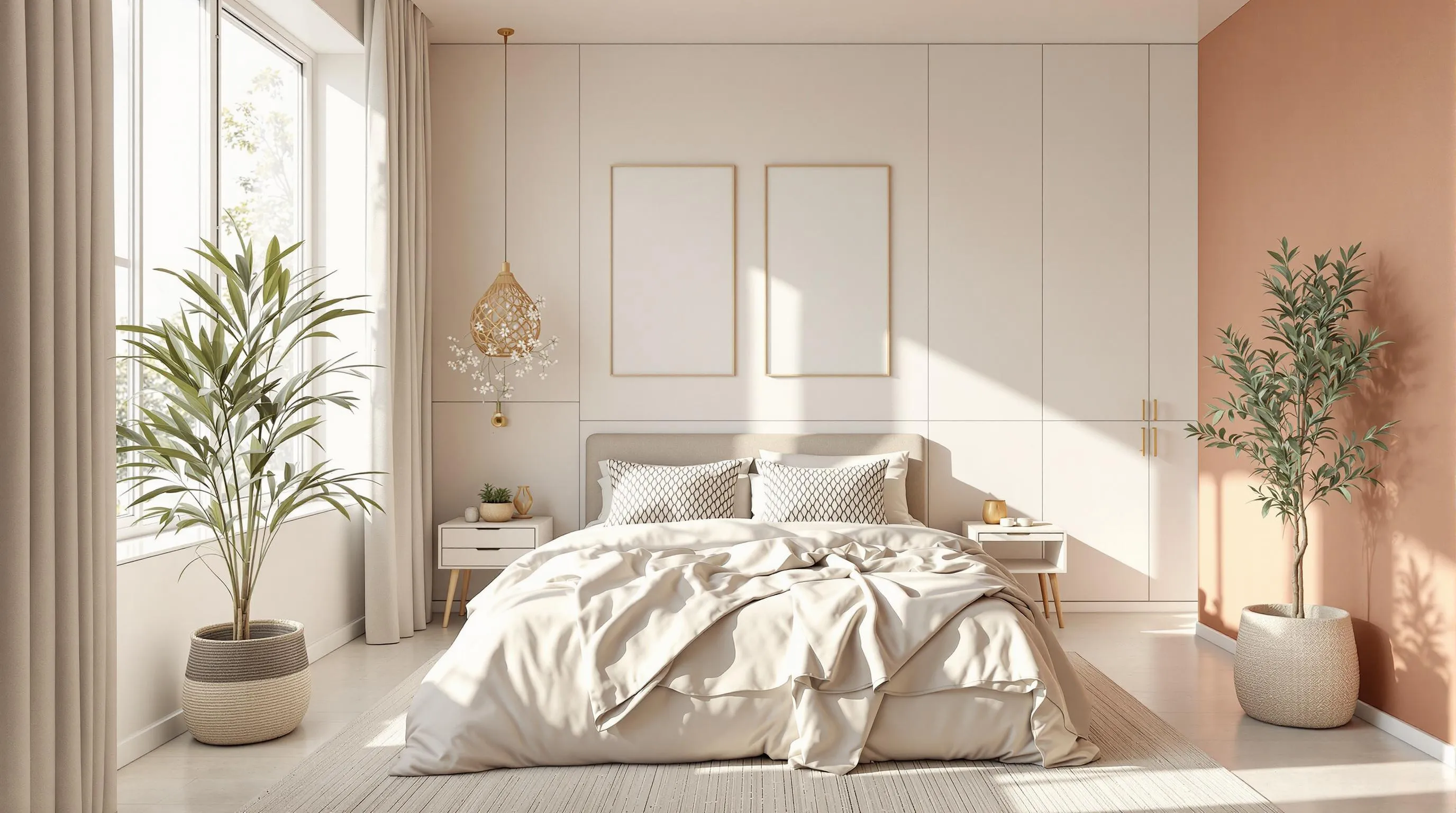
Paint color significantly impacts how we perceive space in small bedrooms, making it one of the most powerful design tools at your disposal. Lighter hues like Benjamin Moore’s Pristine OC-75 and White Dove OC-17 enhance brightness and create an illusion of openness, effectively making the room feel larger than its actual dimensions. Strategic use of bold or dark tones, on the other hand, can add depth and minimize visual boundaries between walls, ceilings, and trim.
The finish you choose matters just as much as the color itself. Satin and gloss finishes reflect light more effectively, amplifying brightness in low-light areas and making small spaces feel more expansive. For instance, applying high-gloss finishes to bold colors like Benjamin Moore’s Onyx 2133-10 or Sherwin-Williams’ Tricorn Black can unify surfaces and enhance perceived height in compact bedrooms.
Monochromatic schemes work wonders in small spaces. Painting walls, trim, and baseboards the same color—such as Benjamin Moore Pashmina at 50% intensity—eliminates visual breaks that can make a room feel choppy or confined. This technique creates a seamless look that allows the eye to move continuously around the space.
Color psychology plays a crucial role too. Neutrals promote calmness and relaxation, while deeper tones like Benjamin Moore’s Savannah Green 2150-30 evoke coziness, making them ideal for creating restful environments. The right color choice can transform not just how a room looks, but how it feels to spend time there.
Accent walls offer another smart strategy for small bedrooms. Using bold shades like Cinnamon Slate 2113-40 from Benjamin Moore or Magnetic Gray from Sherwin-Williams on focal points adds dimension without overwhelming the space. This technique draws the eye to exact areas while maintaining an overall sense of openness.
Soft White Shades for Maximum Light Reflection
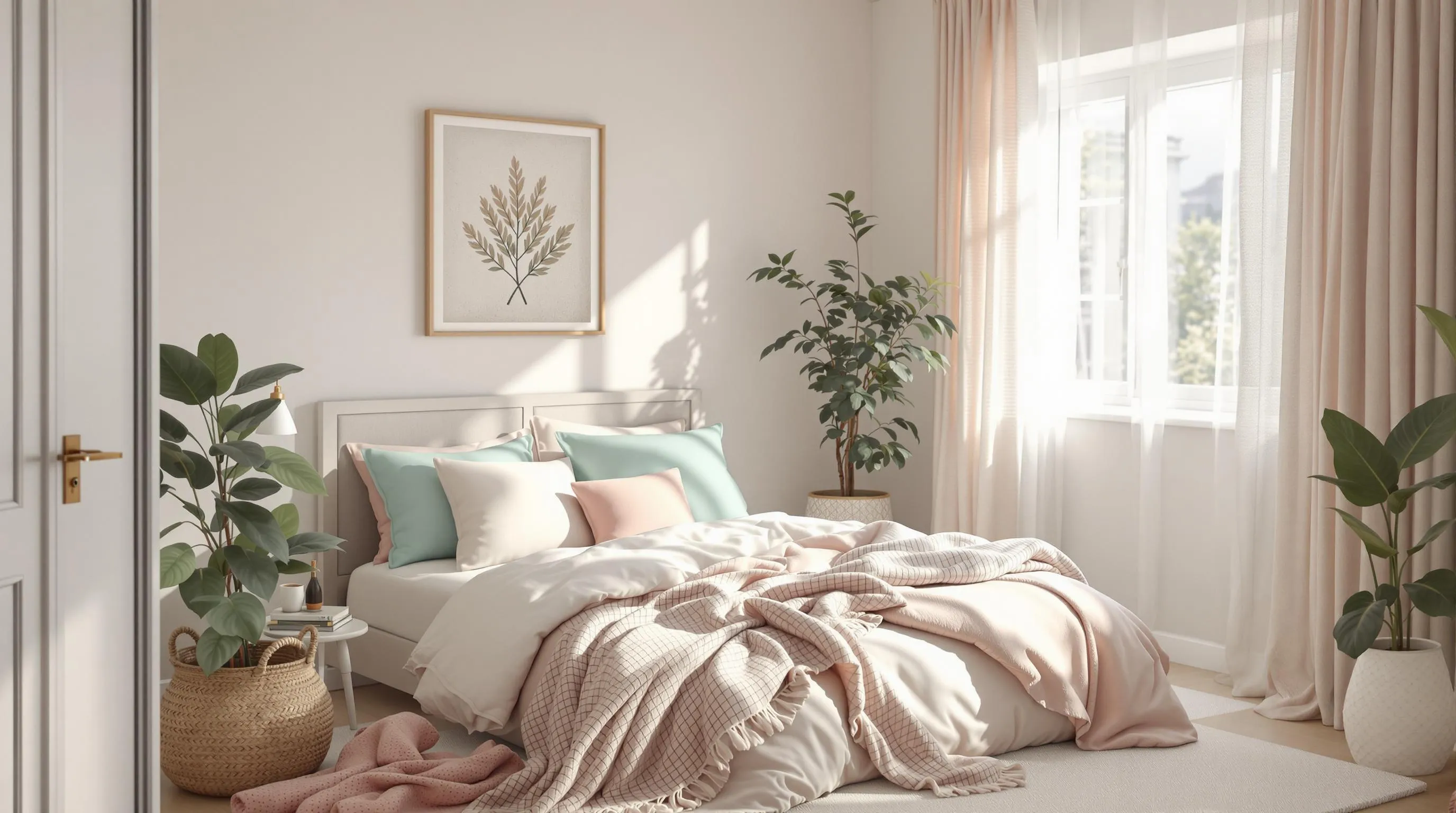
Soft white paint colors are the ultimate space-enhancers for small bedrooms, creating an airy, open feel through their superior light-reflecting properties. These gentle hues maximize natural light, visually expanding your compact space while providing a clean, timeless backdrop for your décor.
Best White Paint Options for Small Spaces
Benjamin Moore’s Pristine OC-75 offers exceptional brightness with minimal undertones, making it perfect for north-facing small bedrooms that need luminosity. White Dove OC-17 delivers a softer approach with its warm undertones that prevent the space from feeling cold while still maintaining excellent light reflection properties. Glass Slipper 1632 introduces a subtle hint of blue that creates a refreshing atmosphere without sacrificing the space-expanding benefits of white paint. For connected spaces and hallways, Chantilly Lace OC-65 provides a crisp, clean white that maintains visual continuity throughout smaller homes. Revere Pewter HC-172 works beautifully as a warm gray-beige option that adds depth while still reflecting sufficient light to enhance spatial perception. Sherwin-Williams Downy SW 7002 rounds out our top recommendations with its classic gray undertones that add sophistication to small bedroom spaces.
How to Keep White Rooms from Feeling Sterile
Texture variations transform white walls from bland to beautiful—incorporate natural fabrics like linen bedding and wool throws to add warmth and dimension without compromising the spacious feel. Bold accent colors can be strategically introduced through accessories or architectural details; Ming Jade 2043-20 or Vintage Vogue 462 make excellent choices for door frames or alcoves that add personality without overwhelming the room. Layering different neutral shades creates visual interest while maintaining the airy atmosphere; pairing Valspar’s Brushed Cotton with cream or beige accessories adds subtle depth that fights sterility. Lighting choices significantly impact how white paint reads in a small space—warm-toned fixtures and bulbs balance cool undertones in bright whites, creating a cozy rather than clinical environment. Maximalist personalities can still express themselves in small white bedrooms by incorporating deeper colors like Savannah Green 2150-30 or soft blush tones as thoughtful accents that add character while preserving the room’s open feel. Benjamin Moore’s Ben Interior paint ensures these whites apply smoothly and maintain their space-improving properties with excellent durability for those who like to refresh their small bedroom’s look frequently.
Light Blue Tones for a Serene and Airy Feel
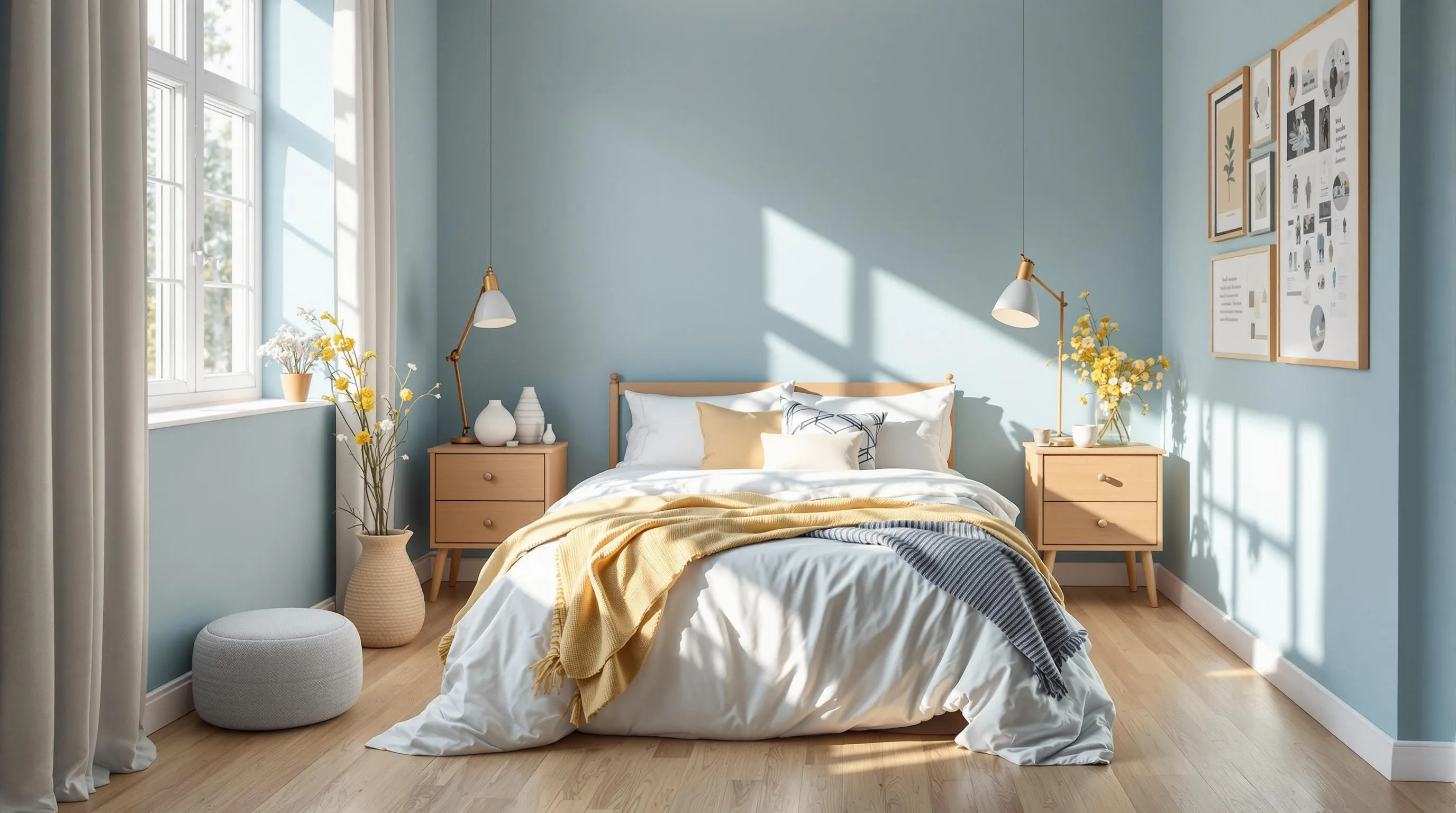
Light blue hues offer one of the most effective color strategies for small bedrooms, creating an illusion of expanded space while promoting tranquility. These cool-toned paints reflect natural light brilliantly, making even the tiniest rooms feel open and peaceful.
Sky Blue Options That Expand Visual Space
Sky blue paint colors work wonders in compact bedrooms by mimicking the openness of the atmosphere. Benjamin Moore’s Breath of Fresh Air exemplifies this effect, absorbing and amplifying available daylight to create a sense of boundless space. These lighter blue tones perform exceptionally well in rooms with limited window access, as they maximize what natural light is available. When applied to walls, sky blues create a receding effect that visually pushes boundaries outward, making your small bedroom feel significantly more spacious. The reflective qualities of these shades ensure brightness throughout the day, eliminating the cramped feeling that darker colors might create.
Pairing Blue with Complementary Accents
Balance is key when working with light blue walls in small bedrooms. We recommend pairing these cool tones with warm neutrals like Benjamin Moore’s White Dove OC-17 for trim and ceilings to prevent the space from feeling too clinical or cold. Wood finishes in lighter oak or maple tones introduce natural warmth that complements blue’s inherent coolness. For a more ever-changing approach, consider adding accent pieces in contrasting whites or soft grays to maintain the airy quality while introducing visual interest. Playful touches of warmer yellows or gentle pinks can infuse energy without overwhelming the spatial harmony. Semi-gloss white trim against matte blue walls defines boundaries and creates depth perception, further improving the room’s dimensional quality. Pastels like PPG’s Olive Sprig work harmoniously with light blues, creating an organic color scheme that reflects light beautifully throughout your small bedroom.
Gentle Gray Hues for Sophistication and Neutrality
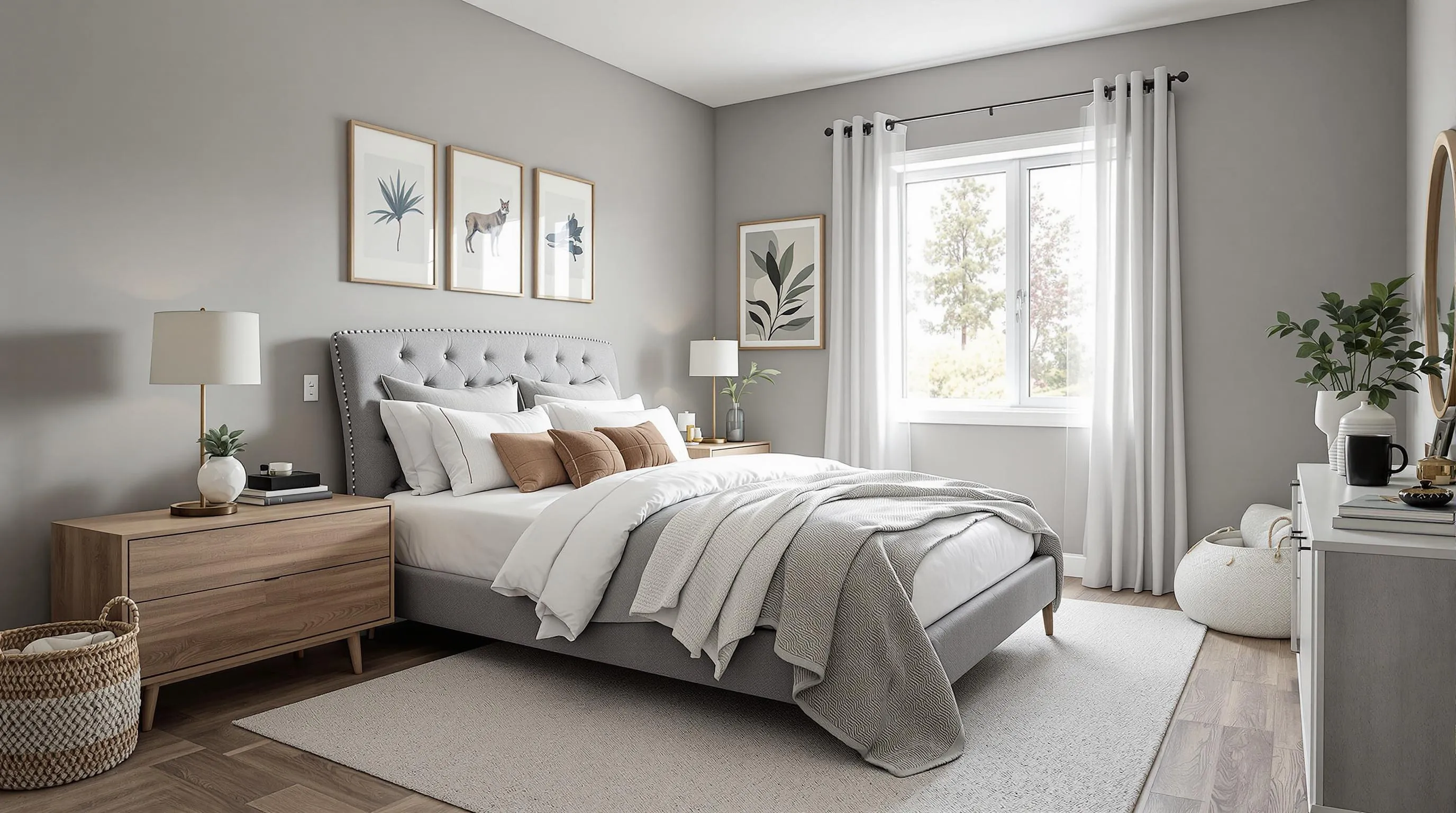
Gray has become a designer favorite for small bedrooms, offering elegant neutrality that creates both sophisticated and calming environments. This versatile color family provides many options that can make compact spaces feel more expansive while maintaining stylish appeal.
Recommended Gray Shades
Benjamin Moore Gray Owl (OC-52) stands out as an exceptionally versatile gray that adapts beautifully to various lighting conditions. This balanced gray creates a soft backdrop that works with nearly any design style or accent color palette.
Benjamin Moore Graytint offers an excellent solution for small bedrooms suffering from limited natural light. It creates a misty, tranquil atmosphere that helps compensate for lighting challenges while maintaining visual spaciousness.
Sherwin-Williams Repose Gray delivers a neutral gray with subtle warm undertones, making it particularly suitable for low-light environments. This shade prevents small rooms from feeling cold or clinical while maintaining the space-improving benefits of gray.
Warm vs. Cool Grays: Choosing the Right Undertone
Warm grays typically contain hints of beige, brown, or yellow undertones that create a cozier, more intimate feeling in small spaces. These shades work exceptionally well in bedrooms with northern exposure or limited natural light, as demonstrated by Sherwin-Williams Repose Gray’s ability to add warmth without heaviness.
Cool grays incorporate blue, purple, or green undertones that often make spaces feel more expansive and contemporary. Benjamin Moore Gray Owl exemplifies this quality with its slightly cool temperament that enhances brightness and creates an impression of additional square footage in compact bedrooms.
Light direction plays a crucial role in gray paint selection for small rooms. North-facing rooms benefit from warmer grays to counterbalance cooler natural light, while south-facing spaces can handle cooler grays without feeling stark.
Designer-Approved Gray Paint Selections
Farrow & Ball Pavilion Gray delivers a sophisticated cool medium gray with subtle blue undertones. Interior designers frequently recommend this shade for modern small bedroom spaces seeking contemporary elegance without overwhelming the room.
Benjamin Moore Misty Gray offers soothing versatility that adapts to different lighting conditions throughout the day. This quality makes it particularly valuable in small bedrooms where light changes significantly from morning to evening.
Benjamin Moore Stonington Gray works beautifully as an accent wall color in compact bedrooms. Designers often suggest using this shade on a focal wall behind the bed to create depth without compromising the spacious feeling of the room.
Pale Green Shades for a Natural, Calming Effect

Pale green shades offer the perfect balance between visual spaciousness and natural tranquility for small bedrooms. These gentle hues create an immediate connection to nature while making compact spaces feel more open and airy.
Sage Green: The Small Bedroom Color Trend
Sage green has emerged as a contemporary trend that’s particularly effective in small bedrooms. This sophisticated, muted green provides a soothing background that complements natural textures and materials beautifully. When applied to walls, sage green creates the illusion of more space while adding a touch of elegance that doesn’t overwhelm the room. Many interior designers recommend sage for its versatility – it pairs exceptionally well with both light neutrals and deeper accent colors. The earthy undertones in sage green help establish a grounded feeling in the space while reflecting enough light to maintain brightness throughout the day.
Mint and Seafoam Options for Freshness
Mint and seafoam green variations bring a refreshing, airy quality to small bedrooms that few other colors can match. These pastel shades reflect light effectively, instantly making the room feel larger and more open. Mint green introduces a subtle energy that keeps the space feeling fresh without becoming too stimulating for a restful environment. Seafoam options, with their slight blue undertones, create a connection to coastal aesthetics that can transform a cramped bedroom into a relaxing retreat. Both shades work wonderfully in rooms with limited natural light, as they help brighten dark corners and create the impression of expanded space. For the best results, we recommend pairing these lighter green options with crisp white trim to enhance their space-expanding properties.
Soft Lavender and Purple Tones for Subtle Drama
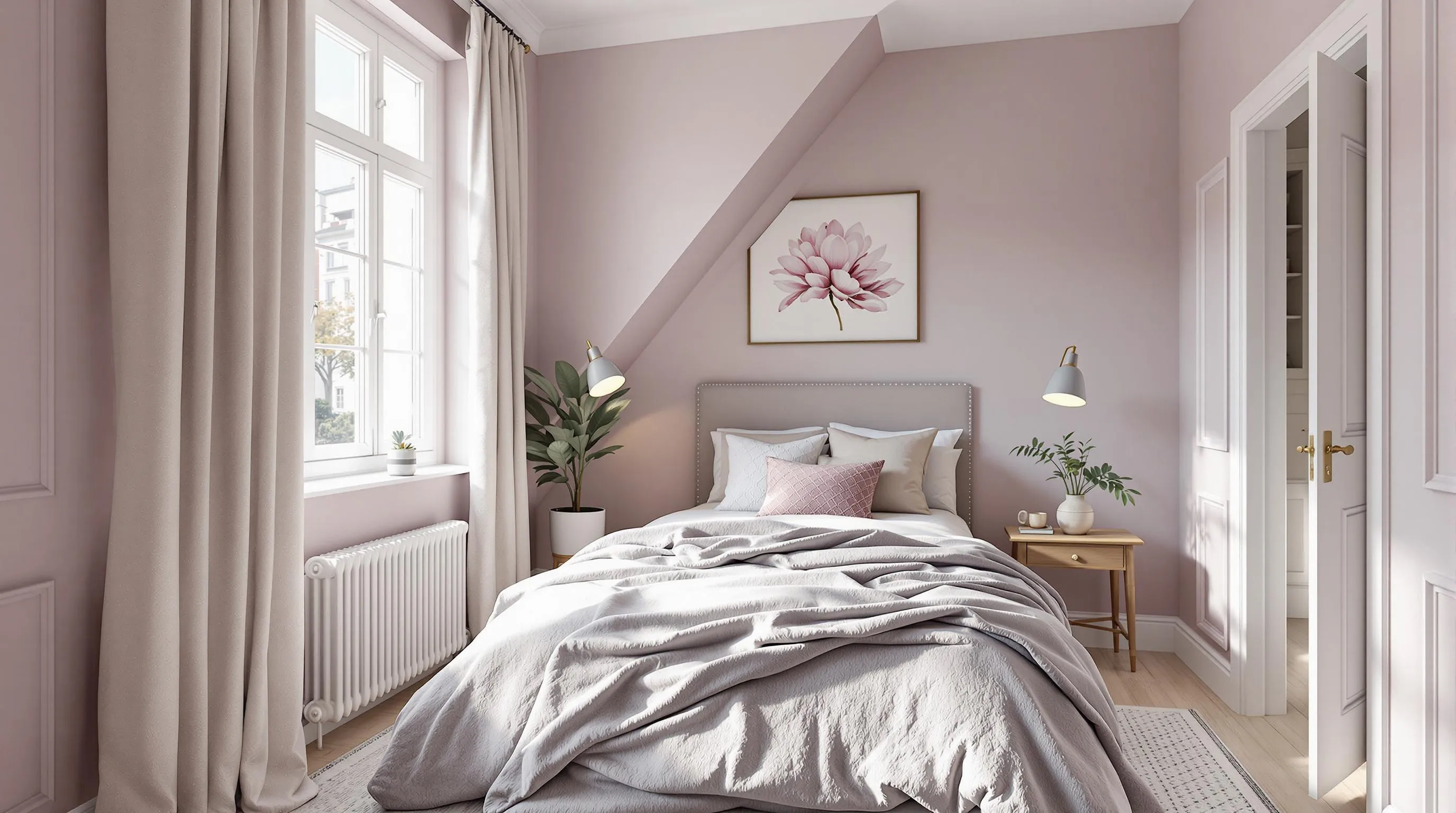
Purple hues offer an unexpected yet effective solution for small bedrooms, adding personality without sacrificing the perception of space. These versatile colors create a sophisticated atmosphere while maintaining the airy feel essential for compact rooms.
Purple Shades That Don’t Overwhelm Small Spaces
Lighter purple variations like soft lavender introduce subtle color while keeping the room feeling open and spacious. Muted mauve and lilac tones work particularly well in bedrooms with natural light, adding warmth without closing in the space. For best results, choose lavender with gray or beige undertones, such as Sherwin-Williams’ “Lavender Violet” or Benjamin Moore’s “Gentle Violet,” which provide color while maintaining a sophisticated neutral base.
Deeper purple shades can work beautifully in small bedrooms when applied strategically. Consider using dusky plum or muted eggplant as accent colors rather than all-over wall treatments. These richer tones create visual interest when applied to nooks, alcoves, or architectural millwork while keeping the main walls in lighter complementary shades. Pairing deeper purples with neutral ceilings and trim in shades like Benjamin Moore’s Revere Pewter HC-172 or Chantilly Lace OC-65 prevents the space from feeling confined.
Creating Balance with Lavender Walls
White trim provides the perfect counterpoint to lavender walls, creating definition and preventing the color from overwhelming the space. Benjamin Moore’s White Dove OC-17 offers a soft white that complements lavender without harsh contrast. Greige accents (like Clare’s Greige) can further ground the lavender and create a sophisticated color story that maintains visual openness.
Lighting considerations play a crucial role when working with purple tones in small spaces. North-facing rooms benefit from cooler-toned lavenders that counteract gray undertones often present in limited natural light. South-facing bedrooms can handle warmer lavender-pink hybrids that glow beautifully in abundant sunshine.
The finish of your paint significantly impacts how lavender appears in a small bedroom. Matte or eggshell finishes minimize wall imperfections while creating a soft, calming effect. Satin finishes provide subtle reflectivity that enhances available light without creating glare, making them an excellent choice for spaces that need brightness.
For those concerned about commitment to purple, consider adjacent hues like Benjamin Moore’s Ming Jade 2043-20 (a soft green) or Glass Slipper 1632 (a pale blue) that offer similar gentle contrast with comparable space-improving properties. When incorporating lavender into your small bedroom, maintain whole-home cohesion by using analogous undertones in connecting spaces to ensure visual flow throughout your living environment.
Blush Pink for Warmth and Dimension

Blush pink adds subtle warmth and visual depth to small bedrooms, creating an inviting atmosphere without overwhelming the space. These soft pink tones reflect light effectively, making rooms feel airier while providing gentle color contrast against neutral furnishings.
Modern Ways to Use Pink Without Looking Juvenile
Achieving a sophisticated blush pink bedroom requires thoughtful pairing with complementary elements. Combine blush walls with matte black accents for a contemporary edge that immediately elevates the space beyond childish associations. Natural wood finishes work beautifully alongside blush pink, creating an organic warmth that feels decidedly mature and intentional. For a more subdued approach, introduce muted grays as companion colors to temper the sweetness of pink with urban sophistication.
Consider using blush as an accent wall rather than covering all surfaces, balancing boldness with restraint for a more curated look. Textured fabrics enhance the adult appeal of pink spaces—think linen headboards, velvet throw pillows, or woven cotton bedding that add dimension and complexity. These tactile elements transform simple pink walls into a layered, nuanced environment that reads as deliberately designed rather than juvenile.
Best Blush Tones for Different Lighting Conditions
Room orientation significantly impacts how blush paint appears throughout the day, requiring strategic shade selection based on natural light patterns:
North-facing or light-deficient rooms benefit from warmer blush hues containing peach or terracotta undertones. These warmer variants counteract the cool light these rooms typically receive, preventing the space from feeling flat or cold.
South-facing rooms bathed in sunlight work better with cooler blush tones featuring gray or lavender bases. These cooler undertones help balance the warm southern exposure, preventing the color from appearing too intense or overwhelming in bright conditions.
Spaces with minimal natural light require careful finish consideration alongside color selection. Matte or eggshell finishes help diffuse whatever light is available, creating a soft, enveloping effect. Semi-gloss variants can strategically brighten exact surfaces without creating distracting glare points.
For optimal results, we recommend testing paint samples directly on your bedroom walls and observing them at different times of day before making your final decision. This allows you to see how your exact lighting interacts with various blush options, ensuring the perfect warm dimension for your small bedroom space.
Light Yellow for Brightness and Positivity
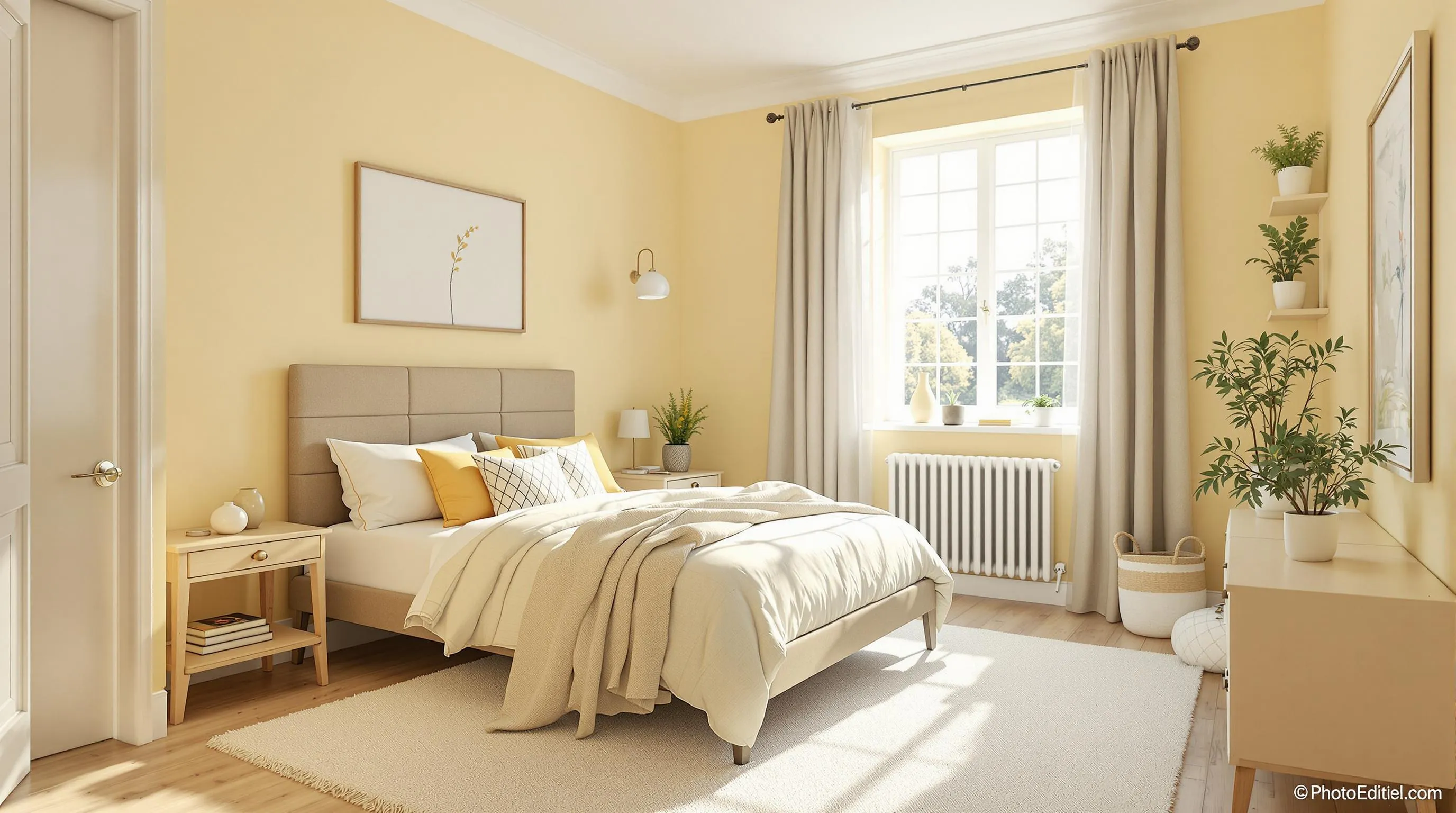
Butter and Cream Yellows That Enhance Small Spaces
Light yellow tones offer an excellent solution for small bedrooms that need both brightness and warmth. Buttery and cream yellow shades add a subtle glow to compact spaces without overwhelming them, creating an inviting atmosphere that feels both cozy and spacious. These soft yellow variations work particularly well in rooms with limited natural light, as they simulate sunshine and create a cheerful ambiance. Benjamin Moore’s “Butter” and Sherwin-Williams’ “Creamy” deliver the perfect balance of warmth without intensity, making small rooms feel instantly more welcoming. Designers often recommend these gentle yellows for north-facing bedrooms that need additional warmth throughout the day.
Working with Yellow’s Reflective Properties
Yellow’s natural light-reflecting abilities make it an ideal choice for visually expanding small bedrooms. This color family bounces light around the room more effectively than many other hues, helping to brighten dark corners and create an illusion of added space. For optimal results, we suggest pairing light yellow walls with white trim and ceilings to enhance the reflective effect. Satin or eggshell finishes amplify this reflective quality while remaining practical for bedroom walls. Natural light particularly enhances yellow’s space-expanding properties, so positioning mirrors across from windows can maximize this effect throughout the day. Complementary textiles in neutral tones help balance the brightness while maintaining the open feeling that makes yellow so effective in small spaces.
Monochromatic Color Schemes for Visual Continuity
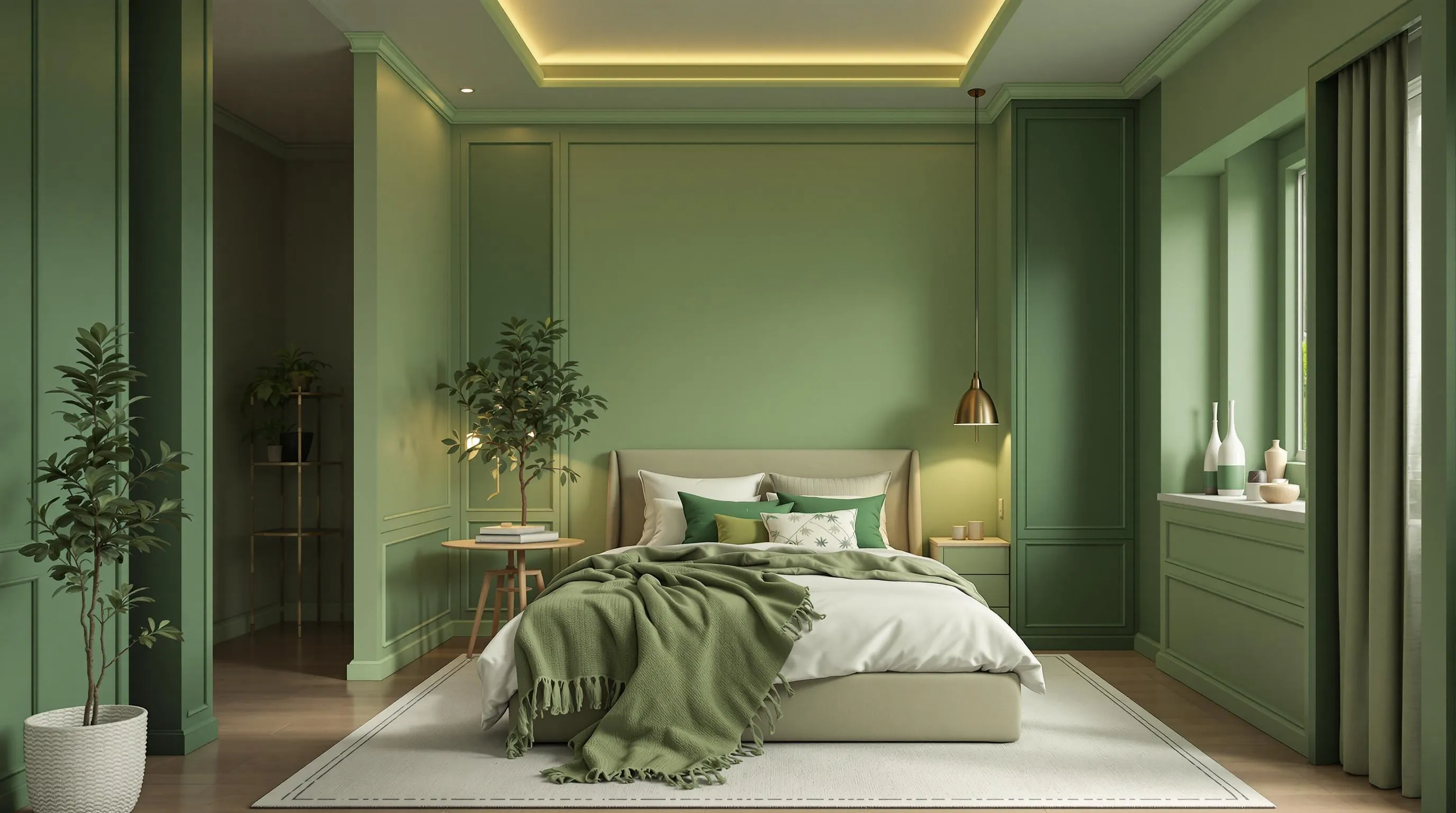
Monochromatic color schemes offer powerful answers for small bedrooms by creating visual continuity that makes the space feel larger and more cohesive. This approach uses varying shades, tints, and tones of a single color to create depth without interrupting the visual flow.
Using Different Shades of the Same Color
Selecting various shades of a single color adds dimension to small bedrooms while maintaining a harmonious feel. Deep greens can anchor the space through accent pieces while lighter sage tones on walls expand visual perceptions. Blues work exceptionally well in monochromatic schemes, with darker navy as trim and lighter sky blue on walls creating subtle contrast without breaking continuity. Neutral palettes featuring different intensities of gray or beige deliver sophisticated results that make small rooms feel more spacious and intentionally designed. According to design experts, using 3-4 different shades of your chosen color creates optimal visual interest without overwhelming compact spaces.
Wall-to-Ceiling Techniques That Expand Space
Extending your paint color from walls onto the ceiling removes the visual stopping point, creating an illusion of boundless space in small bedrooms. Light neutrals like Benjamin Moore’s Pristine OC-75 and White Dove OC-17 work particularly well for this technique, reflecting light throughout the room. Soft colors painted continuously from wall to ceiling eliminate harsh transitions that can make small spaces feel choppy and confined. Designers recommend using matte or eggshell finishes for this application to reduce glare while maintaining the seamless effect. This approach works beautifully with built-in furniture painted the same color, further improving the continuous visual flow that makes small bedrooms feel significantly more expansive.
Dark, Moody Colors: When to Break the “Light Colors” Rule
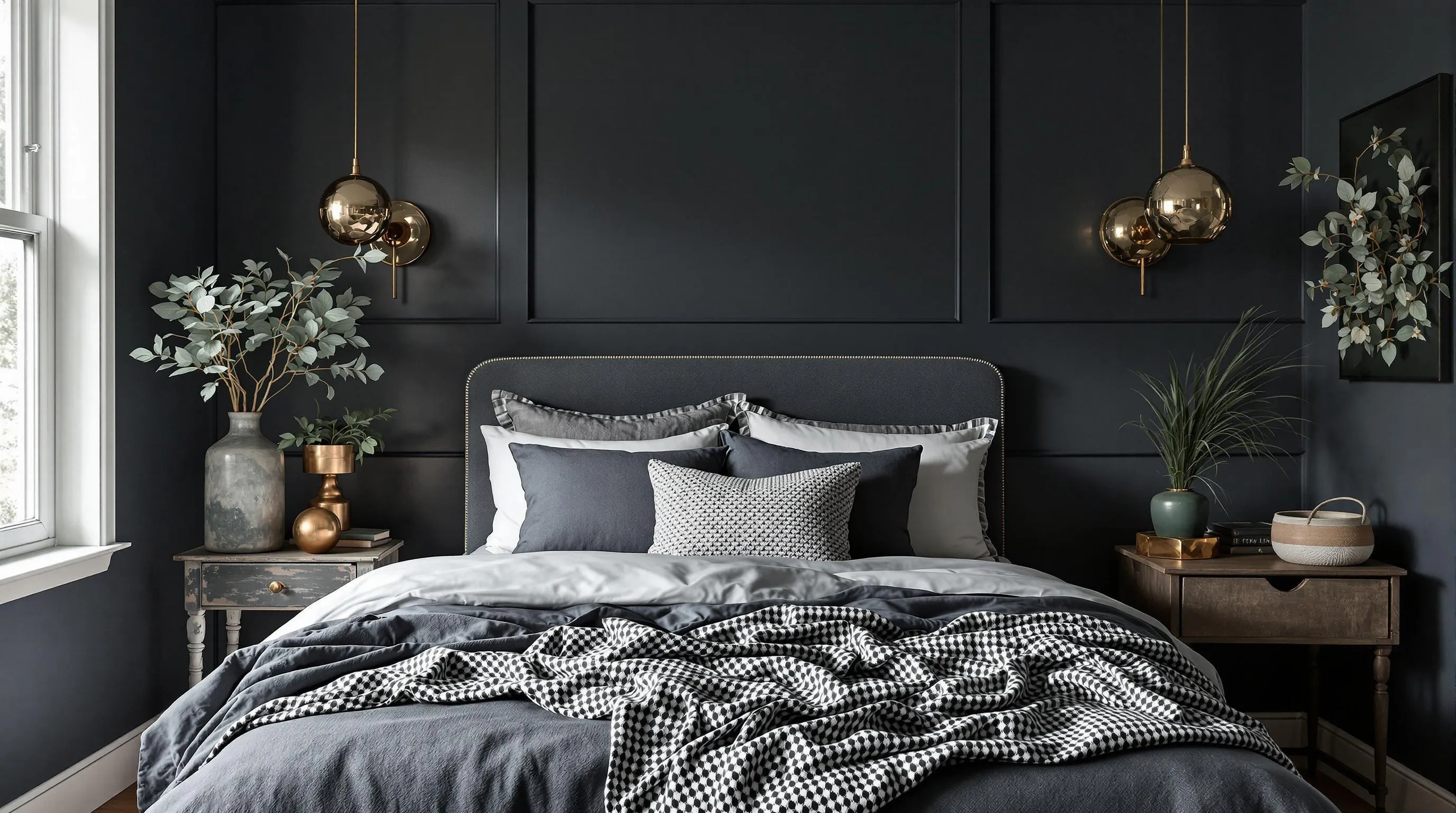
While conventional wisdom suggests using light colors to make small bedrooms feel larger, breaking this rule with darker hues can create dramatic, cozy sanctuaries that embrace intimacy rather than fight it. Dark colors work exceptionally well in small bedrooms with ample natural light, higher ceilings, or when applied as strategic accent walls to prevent a cramped feeling.
Navy, Charcoal, and Forest Green in Small Spaces
Navy blue transforms small bedrooms into sophisticated retreats, with Benjamin Moore’s Dinner Party AF-300 creating an enveloping effect that promotes restfulness. This deep tone adds instant character while maintaining a timeless appeal that works beautifully with both modern and traditional décor elements.
Charcoal gray offers understated elegance in compact spaces, particularly Benjamin Moore’s Onyx 2133-10, which provides a neutral backdrop that amplifies the impact of metallic accents and textured linens. The rich depth of charcoal creates a cocoon-like atmosphere perfect for bedrooms dedicated to relaxation and sleep.
Forest green introduces organic warmth to small bedrooms without overwhelming the space. Benjamin Moore’s Ming Jade 2043-20 or Savannah Green 2150-30 connect interiors with nature, fostering a sense of tranquility while adding visual interest through their rich, saturated tones.
Creating Depth with Unexpected Dark Colors
Bold contrasts elevate small bedroom designs when deep hues like Benjamin Moore’s Cinnamon Slate 2113-40 are paired with lighter trim or ceilings. This balanced approach anchors the space while maintaining visual lightness where it matters most, preventing the room from feeling closed in.
Monochromatic schemes using varying shades of the same dark tone add sophisticated dimension to compact spaces. Experimenting with different values of taupe or greige creates subtle visual interest while maintaining cohesion, particularly effective when incorporated into geometric wall designs for small rooms.
Accent walls serve as focal points when painted in dramatic colors like Benjamin Moore’s Vintage Vogue 462. By limiting dark paint to a single wall, we can anchor the bedroom design while preserving an open feel throughout the rest of the space.
For optimal results with dark colors in small bedrooms, choose paints with smooth finishes such as Benjamin Moore’s Ben® Interior line. These formulations ensure even coverage, which is particularly important in compact areas where every detail is noticeable.
Expert Tips for Applying Paint in Small Bedrooms
Choosing the perfect paint color is just the first step in transforming your small bedroom. The right application technique can make all the difference in achieving professional results. We recommend testing samples on your walls before committing as colors look different depending on your room’s natural light.
For maximum impact use high-quality paint that offers better coverage and durability. Consider painting your ceiling the same color as your walls in lighter shades to create a seamless flow that visually expands your space.
Remember that proper preparation is crucial—clean walls patch holes and prime when needed. Whether you choose soft whites lavender tones or even bold darker hues the key is thoughtful application that complements your space’s unique characteristics. With these color strategies your small bedroom can feel both spacious and perfectly personal.
Frequently Asked Questions
What color makes a small bedroom look bigger?
Light colors like soft white, pale blue, and light gray create the illusion of more space by reflecting natural light. White is particularly effective as it maximizes brightness and creates an airy feel. Monochromatic color schemes also help by creating visual continuity that makes the space feel larger and more cohesive.
Can I use dark colors in a small bedroom?
Yes, contrary to conventional wisdom, dark colors like navy blue, charcoal gray, and forest green can work well in small bedrooms. They create intimate, cozy spaces that feel sophisticated. The key is ensuring adequate natural light and possibly using the dark shade on just one accent wall to prevent a cramped feeling.
What’s the best white paint for a small bedroom?
Benjamin Moore’s Pristine OC-75 and White Dove OC-17 are excellent choices. These soft whites maximize light reflection without feeling sterile. To prevent a clinical feel, incorporate texture through natural fabrics, add bold accent colors, or layer different neutral shades for visual interest.
How can I make a white bedroom feel less sterile?
Add texture through natural fabrics like linen and cotton, incorporate bold accent colors through accessories, make thoughtful lighting choices with warm-toned bulbs, and layer different neutral shades for visual interest. Wood elements and metallic accents also add warmth to white spaces.
Are light blues good for small bedrooms?
Light blues like Benjamin Moore’s Breath of Fresh Air are excellent for small bedrooms. They create an illusion of expanded space while promoting tranquility. Sky blue particularly reflects natural light effectively, enhancing openness. Pair with warm neutrals for trim to maintain warmth and prevent a clinical feel.
What’s a good alternative to white for small bedrooms?
Soft gray is an excellent alternative, offering sophistication while making spaces feel more expansive. Benjamin Moore Gray Owl adapts well to various lighting conditions, while Graytint works in low-light environments. Other good alternatives include pale green, blush pink, and light lavender.
Should I use the same color on walls and ceiling?
Using the same color on walls and ceiling can eliminate harsh transitions and create an illusion of boundless space, making the room feel larger. This technique works best with light neutrals and finishes that reduce glare while maintaining a seamless effect.
What finish is best for small bedroom paint?
Satin and eggshell finishes are ideal for small bedrooms as they reflect light to amplify brightness without showing imperfections. For darker colors, smooth finishes often work best. Avoid flat finishes in poorly lit rooms as they can absorb light and make spaces feel smaller.
How do warm vs. cool grays affect a small bedroom?
Warm grays with beige or brown undertones create coziness and work well in north-facing rooms with cooler light. Cool grays with blue or purple undertones feel more modern and expansive, working better in south-facing rooms with warmer light. Choose based on your room’s light direction.
Can I use an accent wall in a small bedroom?
Yes, accent walls can add dimension without overwhelming small spaces. Use bold shades to draw attention to focal points while maintaining an overall sense of openness. This approach lets you incorporate deeper colors you love without making the entire room feel cramped.









